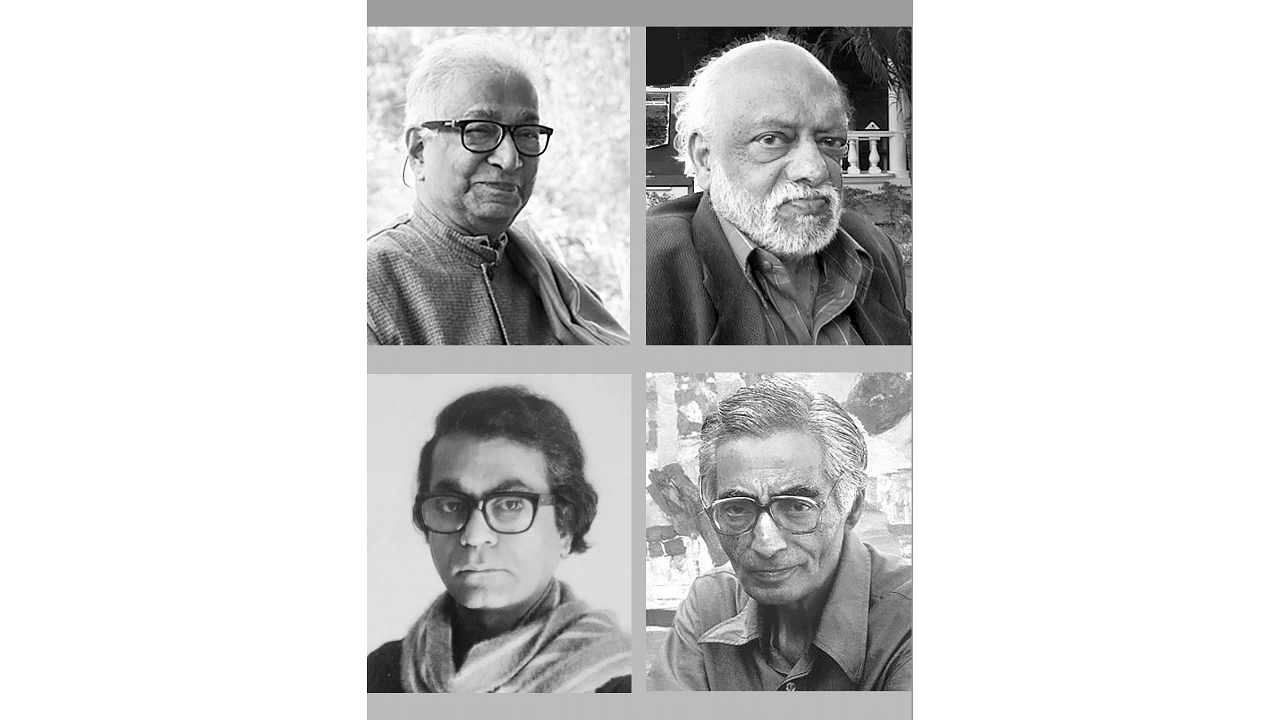
Clockwise from top left: KG Subramanyan, FN Souza, Ram Kumar and VS Gaitonde
This year marks the birth centenary of four renowned and respected Indian artists. These distinguished painters, who came from different regions of the country, pushed the boundaries of creativity and made a lasting impact on Indian modern art. Three of them, namely KG Subramanyan, Ram Kumar, and Vasudeo S Gaitonde, were honoured by the Government of India with Padma Vibhushan, Padma Bhushan, and Padma Shri awards respectively. They also received the prestigious Kalidas Samman Award from the Government of Madhya Pradesh.
The polymath
Born on February 15, 1924, in Kuthuparamba, Kerala, KG Subramanyan is remembered as a versatile artist who explored and experimented with various forms, themes, and mediums throughout his long and illustrious career. Drawing inspiration from local traditions, folklore, and myth, the prolific artist not only created paintings but also sculpted and designed murals using a variety of media, materials, and techniques.
Brimming with allegories and witty anecdotes, his work opened up creatively fragmented spaces in which colourful and playful characters moved freely. “My works have sought to move between the real and the imaginary,” he would explain. “The images have a complex identity, diverse cultural associations and background lore … I am by nature a fabulist. I transform images, change their character, make them float, fly, perform, tell a visual story.”
The enfant terrible
Francis Newton Souza revelled in producing bold and provocative works throughout his life. His personal life was tumultuous, his struggles intense. His paintings featured distorted figures and raw emotions that carried a rebellious spirit, challenged the status quo and pushed the boundaries of image-making. Souza was admired for his boldness and originality and criticised for the explicitness and subversive nature of his art. Reflecting on Souza’s compelling paintings of Christ and the power of his erotically charged nudes, Christopher P Wood of The Guardian wrote: “These were his subjects and the imagery of his most important works ... Souza held on to his wry humour and a healthy scepticism of the establishment in any form. He celebrated the individual.”
The master of silence
By all accounts, Vasudeo S Gaitonde was one of the trailblazers of abstract/non-objective art in India. Born on November 2, 1924, in Nagpur, he studied at the JJ School of Art in Mumbai. Inspired by the philosophical teachings of J Krishnamurthy, Ramana Maharshi, and Zen Buddhism, Gaitonde’s art was driven by a continuous search for spiritual expression and meditative silence.
Often described as a solitary genius and a reclusive artist, he worked slowly and diligently on his paintings. Unlike many of his contemporaries, he was not prolific and devoted time and thought to bring in a rare sensitivity and weightless quality to his pieces. Gaitonde left behind only a few exquisite pieces which earned him a legendary status in contemporary Indian art.
The quiet observer
Like his dear friend Gaitonde, Ram Kumar also considered his art to be a continuous search and a spiritual process. While his early figurative paintings reflected on “the urban predicament, fueled by socialist realism”, his later work embraced a more non-representative form, because: “I could see no meaning in painting street scenes as streets, trees as trees, and rivers as rivers.” Ram Kumar’s Banaras series, which he painted in the 1960s and 1970s, are still considered iconic for their sheer depth and intensity.
Born on 23 September 1924 in Shimla, Ram Kumar remained active throughout his life before passing away on 14 April 2018 in Delhi, at the age of 93. As eminent art critic Richard Bartholomew observed, Ram Kumar was a quiet man, a quiet painter, and a painter of the remembrance of things past.